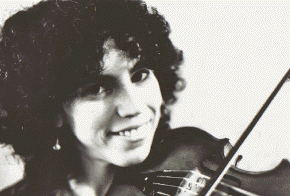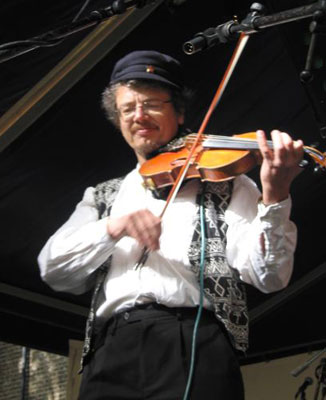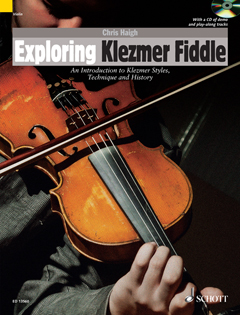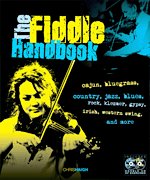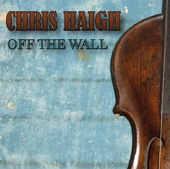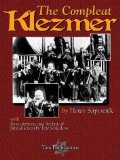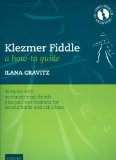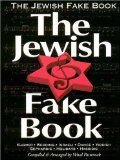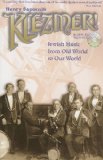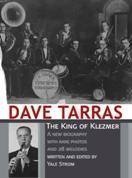
MENU TO FIDDLE STYLES:
VISIT THE FIDDLE CHANNEL FOR FREE FIDDLE LESSONS, TUTORIALS, AND WORKSHOPS!
Klezmer Fiddle LEARN KLEZMER FIDDLE ON THE FIDDLE CHANNEL!
The fiddle and the Jewish Old World
The Klezmorim were the bad boys of the Jewish world. They had got off to a good start in Jerusalem, when at the time of the Jewish Kings there was an elite caste of temple musicians called the Levites. However, with the destruction by the Romans of the Second Temple, the rabbis declared that, as part of the process of mourning, instrumental music would be banned. Whether this ban was intended to last for the next two millennia, rather than just for their own lifetime, was unfortunately not made clear. At any rate this was the start of a perpetual antipathy on the part of the religious authorities towards music, and the end of the high status that musicians had previously enjoyed. Eventually there was a grudging agreement that, since there was a mitzve (religious duty) to make weddings joyful, musicians would be allowed to play on these occasions, though they were viewed very much as a necessary evil rather than as honoured guests in the synagogue. Klezmorim were seen as the lowest of professions, living largely outside mainstream Jewish society, associated with drinking, irreverence and loose living. In his 1888 novel “Stempenyu”, Sholem Aleichem describes the lives of the wandering klezmer musician, belonging to “a distinct and separate species of mankind”. Stempenyu himself (actually based on a real-life fiddler Yossele Drucker (1822-1879) is a hugely talented and popular violinist, leader of a travelling wedding orchestra and like all of his type a carefree, dissolute breaker of young women’s hearts.
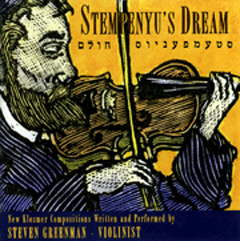
The Jewish diaspora, propelled initially by a long-running series of persecutions by the Roman and Holy Roman Empires, saw Jews dispersed widely throughout Europe, but continued intolerance and expulsions in countries such as Spain and France led to a gradual migration eastwards towards Germany, Poland and what would eventually become the Russian Empire. Around the 9th C Jewish settlements began to grow up along the Rhine in the area referred to in the book of Genesis as Ashkenaz. These were the first Ashkenazi (Central and East European) Jews, and it was here that a mixing of Hebrew and local German dialects produced the Yiddish language- a feature which was to become central to Ashkenazi culture.
From the 15thC onwards there are many written accounts of klezmer bands operating both in the Shtetls (small rural communities) and in the large towns and cities such as Kiev, Kishiniev and Odessa. The profession of musician was generally hereditary, and they were organized into Guilds, the first of which was founded in Prague in 1558,with the fidl (fiddle) as its emblem. A Kapelye (band or orchestra) would be usually led by a fiddler; there would also be a second (sukund, or tweyster) and possibly third fiddle, a bass or cello, several wind instruments, a drum and a cymbalom ( a sort of hammered dulcimer). The second and third fiddles would play the melody an octave down, or add rhythm. Each band would have its own jealously guarded territory and would constantly be on the move, travelling from wedding to wedding. Territorial disputes should be sorted out by the Guild, but there are numerous records of punch-ups between rival bands. Musicians had their own secret language-klezmer sprakh- in which they could discuss music, the size of the fee or of the bride’s vital statistics without being understood by the clients. The term Shmarotsher, for example, was a wedding guest; the word derives from the German for parasite, indicating that the klezmorim perhaps did not always treat their employers with the respect they no doubt thought they deserved! A Hasid was a Botshkar (derived from the Russian for barrel), and a woman could be a borukhe (from the Russian for prostitute). Much of the private lingo was shared with the criminal fraternity, and in the Ukraine coastal city of Odessa, for example, the musicians lived cheek by jowl with prostitutes, black marketers and gangsters in the seedy waterfront Moldavanka district.
LEARN KLEZMER FIDDLE ON THE FIDDLE CHANNEL!
Musicians were beset by restrictions on all sides. Quite apart from the disapproval of the rabbis, the local district authorities, both Jewish and gentile, always treated klezmorim with suspicion. Lobbying by non-jewish musicians ensured that in Prague, for example, it was over a century before the Klezmer Guild was given permission for its members to play at non-Jewish functions, and even then only on Sundays and holidays. In some towns “quiet” instruments (such as fiddle and flute) were allowed, but not drums or brass. The size of the band and the hours they were allowed to play were also subject to restrictions, the rules varying from year to year and from town to town.
One way around these labyrinthine laws was to pretend to be gypsies; professional Romany musicians had much in common with the klezmorim and there was considerable musical interaction between the two groups. Mark Rozsavolgyi (1787-1848) and his gypsy orchestra were crucial to the defining of Hungarian “national” music, original themes from the orchestra being incorporated into Liszt’s Hungarian Rhapsodies. What the Hungarian nobility of the time didn’t know was that Rozsavolgyi was actually Mordchele Rosenthal, and his entire orchestra were jews masquerading as gypsies!THE VOCAL AND RELIGIOUS ROOTS OF KLEZMER
Since the destruction of the Second Temple, music for normal ceremonies in the synagogue was vocal, sung a capella by cantors or khasonim, sometimes accompanied by a choir. The melodies and modes used for these sung prayers often formed the basis for the tunes played by the klezmorim. The vocal inflections of the cantors were also a key influence on the playing style of the klezmer players. There are two essential ornaments used by instrumentalists; the laughing/crying/sighing sound as a note is bent downwards, and the sob, or broken note (the krekhts). Both of these are directly inherited from the cantor. Although klezmer music is instrumental, the badkhn would once have created a direct bridge from synagogue to wedding; his vocal style would be the same as that of the cantor (he may even have been one himself), and during the wedding celebrations he would interact directly with the musicians.
Clearly then, there were strongly religious roots to the klezmer music, but in practice it was secular party music- a point which would be emphasised by the satirical antics of the badkhn.
The status of music in the Jewish world was enhanced by the emergence of Hasidism in 18thC Poland. This was a sect within Judaism inspired by a charismatic leader, the Ba’al Shem Tov (“Master of the Good Name”.) A key part of his teaching was that religious study had become too dry and academic, and that music and dance were a valuable accompaniment to prayer and study, and even a direct route to religious ecstacy. “Attachment to God is primarily attained through melody”. The Hasidim developed the nigun, a wordless song, which could readily be translated into the klezmer repertoire. They were also happy to adopt secular tunes or songs for religious use, sometimes drawing on non-Jewish waltzes, polkas or mazurkas. Hasidic tunes are still a key part of the klezmer repertoire today.THE PALE OF SETTLEMENT
From the 14thC onwards Jews had been gravitating towards Eastern Europe, attracted by the tolerance and sometimes even welcome of some Russian and Polish noblemen. In 1791 Catherine the Great of Russia established the Pale Of Settlement, an area bordering the Russian Empire, and including parts of present-day Poland, Lithuania, Belarus, Moldova, the Ukraine and some of Western Russia. Here Jews were allowed to live and work- valued for their skills and industry, but viewed always with suspicion and kept at arms length. At its height the Pale had up to 5 million Jews, a population which must have supported thousands of klezmorim.
In 1812 Russia annexed the Moldovan province of Moldova from the crumbling Ottoman empire. In this new territory there was more tolerance and freedom, and many Yiddish speakers moved here from elsewhere in the Pale; this was to be the most significant cradle of the more modern forms of klezmer. Gypsies were also allowed freedom of movement here, and there was considerable musical exchange between the two groups. Bulgarian, Turkish and Greek influences also started to make themselves felt. In his book “American Klezmer; its roots and offshoots”, Mark Slobin traces an evolutionary development from the Sirba, a chain dance found throughout Moldova to the Bulgareasca (“In the Bulgarian Manner” following the migrations in 1812. This dance developed into the Bulgarish and became central to the klezmer repertoire, gradually shouldering out the sher and freylechs, finally being renamed the Bulgar in America. The distinguishing feature of all these new dance forms was the presence of triplets scattered throughout the melodies- a feature rarely found elsewhere in the klezmer repertoire.The southern cosmopolitan port cities of Constantinople and Odessa were also important sources of cross-fertilization for klezmorim; here they were brought into close contact with Sephardic Jews (with their strong Spanish and Arabic influences) , as well as with Greek and Turkish music. The period from 1855-1881, when Czar Alexander II was on the throne, were productive ones for Jewish cultural life; he wanted to modernise and westernise his empire, and undertook various liberalising reforms. For the first time Jews were allowed to study in the formal musical establishment. The St Petersburg Conservatory was established in 1868, with Jewish violinist Leopold Auer (1845-1939) as Professor of Violin. This was to be the beginning of a wave of virtuosic Jewish violinists such as Jascha Heifitz and Efrem Zimbalist who were able to move from the narrow and restrictive field of klezmer to the much broader and more lucrative concert stage. A style of violin playing which became known as the “Russian Sound”; powerful tone, wide vibrato and extravagant glissandi were all a direct result of this klezmer influence.
Pedotser was the stage name of the Jewish violinist and composer Moyshe Kholodenko (1828-1902). Like Josef Drucker (Stempenyu) he was from the Ukrainian town of Berdichev, and he was one of the few klezmorim to attain fame outside the Jewish community in his local area. He is also almost unique in that his klezmer compositions were written down; some of his manuscripts ended up in the collection of Moshe Beregovski- a Russian Jewish ethnomusicologist who did a great deal to study and preserve the old world klezmer music of the 19thC and early 20thC. (Beregovski was, incidentally, in the 1930’s, the first to use the term klezmer as a genre of music rather than a musician)
This was also the time when the first Yiddish Theatres were established. Abraham Goldfarden (1840-1908) was a poet and journalist; in 1877, in the Romanian town of Jassy he brought together a group of klezmorim, badkhonim, cantors and actors. With them he created an art form not unlike the English Music Hall or the American Vaudeville, but in Yiddish. This was the first time there had been Jewish entertainment for its own sake (ie. not for a wedding or religious holiday).
It was an immensely popular idea, and quickly spread throughout the Yiddish speaking areas of Eastern Europe.The continuing war against the Ottoman Empire ensured that many Jews were called up for military service. For klezmorim or for anyone with musical aptitude this often meant joining a military band; playing waltzes and quadrilles in the Officers’ Mess was a whole lot more attractive than carting a rifle up to the Front. This military experience had a positive effect on klezmer as a whole, introducing musicians to modern manufactured instruments such as brass and woodwind, teaching them a wider popular repertoire, and instilling discipline and rigour in their playing. The insistent, snare-heavy drum style still heard in modern klezmer bands can be traced back to this period, as can the rise of the clarinet and the decline of the fiddle. The clarinet, though with a similar voice, range and expressiveness, is louder than the fiddle and can easily dominate a band. The days when the fiddler was automatically the band leader were numbered.
The relatively liberal period for Jews of the Russian Pale came to an end in 1881 with the assassination on Czar Alexander II. Under the reign of his son, Alexander lll there was a brutal clampdown on civil liberties, with the Jews a particular target. Arrests, murders and widespread pogroms soon overwhelmed the Jewish population, and this was the start of a massive period of emigration to the United States, which would last until 1924, when the doors finally slammed shut. Some two and a half million East European Jews made the trip to Ellis Island, in search of the goldene medina (land of gold) ; many of these settled in New York’s Lower East Side.
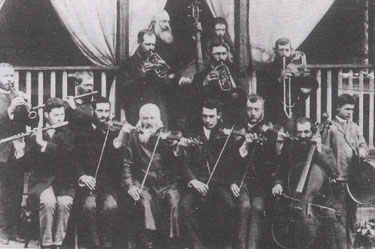
KLEZMER EMIGRATES TO AMERICA
The story of the emigration of klezmorim to the US can be told in miniature through the lives of two of the most influential clarinettists-n Naftule Brandwein and Dave Tarras.Naftule Brandwein (1889-1963 ) was born into a klezmer family in a shtetl in Galicia, now western Ukraine. His father was a fiddler, badkhn and leader of the family band, with whom Naftule played at weddings and wine cellars around Poland until 1908 when, along with nine of his thirteen brothers, he emigrated the US. He quickly made a name for himself, adopting the title “The King of Jewish Music”. As well as being an outstanding player, Brandwein became famous for living to the full the sex, drugs and rock’n’roll lifestyle of the stereotypical klezmer; a drinker, gambler and womanizer, he is said to have driven his car at high speed through the winding roads of the Catskills while simultaneously entertaining his passenger with his clarinet; to have frequently played on stage with his pants down, and to have been the favourite musician of the Jewish Mafia, Murder Inc. He rarely held down a job for long, but despite all this his outstanding playing- fast, fluent, highly decorated and inventive, was highly influential.
Among his chief rivals in America was Dave Tarras (1897-1989). In their personal lives the two were as different as chalk and cheese; Tarras was a sober, dignified and hard-working musician. He was born in Podolia in the Ukraine into a musical Hasidic family. He learned from his father, and by the age of 9 had mastered the guitar, balalaika, flute and mandolin, finally taking up clarinet in his early teens. At the age of 18 he was drafted into the army of the Czar, where he served in a military band until the army’s collapse amid political chaos and revolution in 1918. In 1921 he joined the flood of emigrants and headed for New York. Unlike Brandwein he was musically literate, and soon after his arrival he replaced Brandwein in the Joseph Cherniavsky Yiddish-American Jazz band, a novelty vaudeville outfit which performed in the costume of both Cossacks and Hasids, in front of a backdrop of grotesque Hasidic caricatures. Though less of a self-publicist than Brandwein, he was soon regarded by many as the true King of Klezmer. He is credited with being the chief populariser of the Bulgar, which by the mid 20thC had become the principal dance form among klezmer musicians.EARLY KLEZMER RECORDINGS
Both Tarras and Brandwein arrived in the US at a time when the recording industry was shifting into high gear, and the companies had latched on to the idea that each ethnic group in the great Melting Pot represented a separate market ripe for exploitation. Among the earliest American recordings of Jewish musicians was in 1913, when the Hebrew Bulgarian Orchestra, led by trumpeter Abe Elenkrig laid down some brassy marching band style tracks. It was typical of these early recordings that most of the melody was unison lines from several instruments. Bandleader Abe Schwartz, himself a violinist and pianist, pioneered the idea of having a single lead instrument to play either melody or improvised solo- an idea paralleled in the jazz world as soloists like Louis Armstrong and Sydney Bechet began to emerge as star soloists from among the previous more anonymous collective ensembles. Chief among the Record companies signing klezmer musicians were Victor and Columbia, with nostalgias for the Old World being the chief marketing strategy. These early recordings had an important effect on the transmission of style and repertoire. For the first time, individual tunes became codified and standardised. Whereas before there may have been dozens of different versions of every tune, now the first successful recording would be seen by many as the “right way” to play a tune.
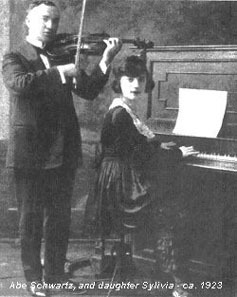
A recording industry was already active in Europe. Victor had sent Fred Gaisberg to London as early as 1899, from where he travelled through much of eastern Europe including St Petersburg, Warsaw, Bucharest and Budapest, making field recordings of Jewish Musicians. There were also independent, European-based companies chasing the same market, including most notably Syrena in Warsaw. Among the artists on this label was the somewhat mysterious V Belf’s Romanian Orchestra, recorded between 1911 and 1914. Belf was actually from the Ukraine; the use of the word Romanian was probably more of a marketing ploy than anything else. Around 30 tracks were recorded, including a many (such as Odessa Bulgar) which are still (possibly because of these recordings?) staples of the repertoire. The ensemble consists of clarinet, two violins and cello. There is also piano- possibly introduced for the first time for the purpose of this recording. As with the early recordings of Irish traditional music, the sudden inclusion of chords to what had previously been largely melodic music was somewhat ham-fisted. The recording quality is poor, and the clarinet dominates the sound, so that little can be gleaned in terms of style or ornamentation from the rather ghostly sounding violins. Nevertheless these recordings are one of the chief surviving insights into repertoire and style of Old World klezmorim. They have been widely used as source material in the late 20thC klezmer revival, changing hands mostly in the form of hand-copied cassettes. As far as I’m aware they are still not available in cd.
Meanwhile, back in America changes were underfoot in the klezmer world. The Jewish wedding, still a substantial earner even for the recording stars like Tarras and Brandwein, was rapidly evolving. The tradition of using a Badkhn to organize events was in rapid decline, but weddings were still lavish events, often held in new, purpose-built catering halls, with the head caterer increasingly calling the shots. The bar mitzvah, a boy’s coming-of age ceremony, which had been previously a small family gathering, in America quickly became a large and expensive status symbol for Jewish families, providing further opportunities for musical employment. In terms of repertoire, there was a constant tug-of war between the two opposing forces of nostalgia (which demanded as many of the old numbers as possible, assimilationism and modernity, which called for the inclusion of more mainstream American popular material. The end to mass immigration which followed the 1924 Reed Immigration Act, cut off the supply of “Old-Country-bumpkins”, and from here on American and crossover material started to usurp the older shers and freilechs. The more esoteric ritual dances such as the Broyges Tanz were ditched in favour of new non-Jewish material such as the Hesitation Waltz and the Turkey Trot.
YIDDISH THEATRE AND "BEI MIR BIST DU SCHON "
The Yiddish Theatre, already well established in Europe, grew rapidly in New York; by 1910 there were thirteen of them in The Lower East Side. The audiences thrived on the diet of schmaltzy, tragic, melodramatic, and humorous songs, many of which became big hits. Khusn Kale Mazeltov came from a show in 1909, and soon became one of the must-have numbers for the dance repertoire, and was often the tune played immediately after the glass was broken and the end of the wedding ceremony. Many of the songs performed at the theatres were Yiddish versions of current American popular songs; hence “Yes, we have no bananas” became “Yes, Wir Hobn Keyn Benenez!”. The biggest hit of all to come from the theatre was Sholem Secunda’s Bai Mir Bistu Sheyn. This was originally written for the 1932 show “I would If I could”. The song was a hit with audiences but these were the lean depression years and the show soon closed. Some years later in 1937 Secunda travelled to Hollywood and attempted to sell the song to Warner Brothers, who turned it down, considering it “too Jewish”. Back in New York, Sucunda got a call from Kammen publishers (a company incidentally which printed the first sizeable collection of klezmer and east European tunes, still in print today). To Secunda’s surprise, they wanted the rights for Bai Mir Bistu Sheyn. Considering that the song had had its day, he was happy to let it go for the princely sum of $30. Kammen obviously knew what they were doing; they rapidly licensed it to TB Harms publishing- ironically a subsidiary of Warner Brothers- who placed the song with the Andrews Sisters. By the end of the year the song was a huge hit all across America- the biggest Jewish-mainstream crossover ever. It’s still very popular today. The Yiddish title and text has led to a carnival of mis-spelling and mis-pronunciation. The meaning of the song is “To me you are beautiful”. The Yiddish pronunciation was kept by the Andrews Sisters, but for some reason the title was changed to German;” Bei Mir Bist Du Schon” Blissfully unaware of either German or Yiddish, audiences will ask for “My dear Mister Shayn” and even “The Bear Missed the Train”!
KLEZMER JAZZ
One significant feature of the song is that it is a good representation of the increasing trend towards klezmer/jazz fusion. This had started on the Vaudeville circuit with bands like Joseph Cherniavsky’s band, which had tight, modern arrangements but no real jazz soloing. The Oriental fox-trot was a genre popular in the 30’s, with eastern-sounding melodies but a jazzy feel; the most successful of these was Leena from Palesteena by Eddie Cantor, based on a bulgar called “Noch a Bisl”. The black singer and bandleader Cab Calloway did a version of the Yiddish folk song Ot Azoy. The success of Bei Mir Bist Du Schon opened the door to more klezmer jazz. The Andrews Sisters followed up their hit with Joseph, Joseph, based on another Yiddish theatre song, Yossel,Yossel. Trumpeter Ziggy Elman had played klezmer before turning to jazz and joining Benny Goodman’s band. They had a hit with an old Yiddish tune, formerly called Der Shtiller Bulgar (the quiet bulgar), given new lyrics, a swing arrangement and a new title And the Angels Sing. Interestingly, whilst today the majority of klezmer musicians are also fluent jazz players, despite the crossover opportunities and the healthy state of both jazz and klezmer at the time, the majority of Jewish musicians were comfortable in only one camp or the other. Ziggy Elman was one of the few who could both play the bulgars and a hot jazz solo.
Klezmer Jazz was always popular with with the Jewish public, because it allowed them them the luxury, within a single record, of feeling both nostalgic and modern, Jewish and American.
Jewish musicians had become so entrenched in every aspect of the music business in America- as players, composers, bandleader, publishers and agents that the industrialist Henry Ford- an arch-conservative and fervent fan of the hoe-down, railed that “Popular music is a Jewish monopoly. Jazz is a Jewish creation…the mush, slush and sly suggestion, the abandoned sensuousness of sliding notes are of Jewish origin!”THE DECLINE OF KLEZMER
The Americanization and dilution of klezmer proceeded hand-in hand with the assimilation and secularization of the Jewish-American population. The term klezmer itself (still at this time attached to the musician rather than the style) came to be seen as derogatory, implying an old fashioned, musically illiterate folk musician. Whilst those born into klezmer families usually continued as musicians, they were finding far more opportunity in jazz, popular or classical music. The repertoire, previously rich and diverse, was rapidly narrowing as demand for it decreased at weddings. The style was by now referred to simply as “the bulgars”, and for most Jewish wedding bands a list of one or two dozen tunes would be more than enough. There had also been a steady influx of Israeli tunes; hebrew folk songs associated with the Zionist movement and the birth of the state of Israel. Whilst popular (Hava Nagila was such a song from the beginning of the century), these songs were simpler and far less challenging than the old European repertoire.
Klezmer revival
As the swing era faded in the 1950's so did klezmer, until by the 70's the old tunes were rarely heard. Young Jewish musicians were strongly represented in the fields of folk, American old-time and bluegrass (often calling themselves Jewbillies!) to such an extent that the Appalachian fiddler Tommy Jarrell is said to have asked Harry "Hank" Sapoznik-"Don't you people got none of your own music?". Intrigued, Sapoznik decided to find out whether indeed they did or don't (!), and his process of rediscovery of Jewish musical roots was a key part in what has proved to be a widespread and sustained klezmer revival. With help from surviving klezmer musicians(most notably the fiddler Leon Schwartz) and the invaluable aid of old '78 recordings (aptly described as "musical Rosetta Stones") he started to recreate the sounds of the 20's New York bands with his new group Kapelye. Besides helping to reissue many of the old recordings (among the earliest are those by the Belf Orchestra) and writing an essential introduction to the style (The Compleat Klezmer), he has also pioneered the noble art of klezmer banjo playing (trust me on this one!). It was not until this recent revival that the term Klezmer came into common use, and now for perhaps the first time it could be concert music as well as just for dancing.
The cause was soon taken up by others, notably Andy Statman and the Klezmorim, and by the 80's there was whole tide of new bands.
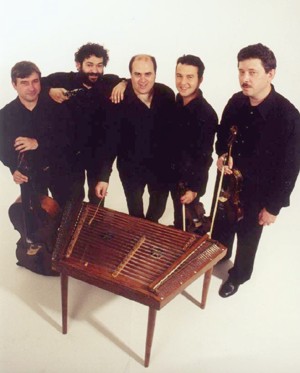
Budowitz
Some, such as Budowitz, strive to recreate the soul of 19th century Klezmer, as do Brave Old World, which features violinist Michael Alpert.
Others have a distinctly modern approach, fusing jazz and latin with the more traditional elements. First and foremost among these remain the Klezmatics, who worked with the classical violinist Itzhak Perlman on the project In the Fiddler's House which spawned a TV documentary, concert tour and CD.
How many band names begin with Klez...?
When the Klezmatics entered the fray on the far left wing, as “The Planet’s radical Jewish Roots band”, they set a mood of irreverent, anarchic, iconoclastic fun. They actively celebrate the homosexuality of some of the band, whilst their tune Mizmor Shir Lehanef is written in praise of the path to enlightenment- not through the Torah, but through cannabis. Here was a band which could fill rock clubs and out-hip the hippest audience, whilst at the same time being a serious and highly respected klezmer band. They also provided inspiration for the legions of new bands worldwide who were scratching their heads in search of the perfect name. The names Klezmernauts, Klezical, Klezmechaye!, Klezmos, Klezmotones, Klezmeydlech, Klezmokum, Klezamir, Klezmorim, Los Klezmeros, Kleztraphobix, Klezmic Noiz, Klezcetera, Klezmocracy and Klezgoyim are already taken. For my money the prize has to go to the New York lesbian band, Isle of Klezbos. I drew the short straw when I came up with the blindingly original Klezmania for my band in London. This being in the days before Google, I was blissfully unaware of Klezmania (Australia), Klezmania (San Fransisco), and Klezmania (Boston). Doh!
Among the more imaginative names relinquishing the K word are the Mazeltones, the Shtetl Blasters, Shir Fun, Take the Oy Train, the Red Sea Pedestrians and the Vulgar Bulgars. Yid Vicious has among his track listings, such gems as “Anarchy in the Ukraine” and “Never mind the Cossacks”. Clearly an ethos of fun, cosmopolitanism and secularism is the order of the day for the majority of new klezmer outfits.
Klezmer fiddle ornamentationA founder member of the Klezmatics is violinist Alicia Svigals, whose playing in many ways defines modern klezmer fiddle playing. With only the '78's and the help of old New York fiddler Leon Schwartz, she has both reconstructed and personalised the sound which once dominated klezmer. Her playing is emotive and soulful, drawing on the laughing and crying sounds heard both in the clarinet and cantorial singing styles. There is frequent bending up to or down from a note, and she makes much use of the krechz,(or Krekhts) a short sobbing ornament played with the 4th finger at the end of a note. Rapid trills (dreydlakh) are common, and she often creates false harmonics by lightening the pressure on the bow, giving a haunting whisper to the note.
Alicia Svigals
In "The Absolutely complete klezmer songbook", Yale Strom lists five core techniques or "dreydlekh" of klezmer playing:
1.Glitshn; slippery, sliding notes or glissandos
2. Krekhtsn; groans or moans- moaning, aching long notes
3.Kneytshn; folds, wrinkles or creases- notes which are turned into sobs
4.Tshoks; notes full of bluff and swagger; bent notes creating a laughing effect
5.Flageoletts; small, flute-like whistling harmonic tones.
A classical training is a distinct advantage for a klezmer fiddle player,as use of the higher positions is often required, and a strong, rich tone is essential. Improvisation is important, though on a strictly limited scale; the jazz idea of "blowing over the changes" is generally frowned on in mainstream klezmer ; it's more a case of each melody player demonstrating a degree of individuality, even when playing in unison. This is often described as Heterophony, or "independant togetherness!) The keys are fortunately violin-friendly, more often than not being in Dm and F.
KLEZMER REPERTOIRE
The klezmer repertoire in 19thC Europe was based around the different ceremonies and traditions of the Jewish wedding, and includes a huge range of different tune types- some for listening, and some for dancing. Because they were living in a highly cosmopolitan area, playing for many different races and classes of people, the east European klezmorim had a vast repertoire. In his biography of clarinettist Dave Tarras, Yale Strom identified the following amazing range of tune types played by a typical klezmer band;
Baveynen, bazetsn, bazingen, bedekn, bezem, broyges, bulgarish, cakewalk, chaconne, czardas, dobronotsh, dobridyen, doyne, dzhindobri, fandanca, fantazi, foxtrot, freylekhs, gas-nign, gut-morgn, halhna'a, honga, hopke, hora, korohod, khupe, khusidl, kosher, kolomeyke, koletsh, kozatshok, kozattshka, krakowiak, krentsel, lancer, lenediks, mazltov, mazurkas, mekheteneste, mignon, mitzve, nign, oberek, padespan, patsh, pleskn, polka, quadrille, reydl, severs, sher, shimmy, shtiler, shtekn, shver un shviger, sirba, skotshne, tango, terkisher gebet, tikhl, tish-nign, vivat, vulekhl, waltz, wingerka, zhok and zogekhts.
By early 20thC, when the focus of klezmer had moved to America, many of these tune types had become redundant. Since the klezmer revival, they are once more in use as concert pieces. Here are some of the more common ones:
- Mazltov Dobriden (congratulations and greeting); used to welcome the guests as they arrive at the wedding. This is a non-dance tune.
- Tsu Der Khupe. The khupe is the wedding canopy, and this tune is a slow processional tune played as the bride makes her stately approach.
- Fun Der Khupe played as the happy couple leave the khupe.
- The Broyges Tants (Dance of Anger and Reconciliation); this was played for the mothers of the bride and groom (mekhutenistas) who were assumed to view one another with suspicion if not loathing. The first section is slow and menacing, where the two circle each other in a threatening manner, while the second half speeds up as the tension lifts, the two mothers join in a joyful dance, and the frank exchange of views regarding the cost of the flowers, the choice of venue and the inebriated state of the groom is temporarily forgotten.
- Patsh Tanz; a lively hand-clapping dance
- Ot Azoy ; That’s the Way (we dance with the mother- in-law); also Mekhuteyneste Mayne (My dear mother-in law). Played, one hopes, with sincerity.
- Doina; unlike most of the others in this list, the doina is for listening, rather than dancing. It is a semi-improvised rubato piece led by the fiddle or clarinet, and is the opportunity for the soloist to display his virtuosity and justify his exorbitant fee.
- Zhok;a slow 3/8 tune, also called hora. with emphasis on beats 1 and 3, sometimes described as a limping rhythm. (The hora is not to be confused with the up-tempo Israeli circle dance of the same name, or the Horo, a Balkan dance often in asymmetric metre.) Unusually, we know specifically where this came from; it was commissioned by Moldovan aristocrats in the 1830’s, who wanted a new dance created. The Moldavian Hora in Henry Sapoznik’s “Complete Klezmer” is such a tune; it appears on the Belf Orchestra recording under the title Bolgarski Zhok.
- Sher; a lively Russian set dance, with short, simple tunes played in a medley. The Sher would be played on request only, and with the handing over of a suitably substantial tip. The dance ended in all the guests forming a long chain, which then wound in on itself, bringing sometimes into embarrassingly intimate contact, and often terminating in a punch-up!
- Freylechs; something of a catch-all term for straightforward 2/4 tunes played for a line dance. The name means “happy”. Often derived from religious melodies. Musicologist Mark Slobin considers that the Sher and Freylech are in fact one and the same musically, though their function was somewhat different. The khosidl is also virtually indistinguishable from the freylechs.
- The Bulgar; similar to the Freylech, but derived from the Bessarabian region of Romania. This had less religious connotation than the freylech, and in America it became the dominant tune form. It is differentiated from the freylech or sher by the frequent occurance of triplets within the molody. Many new bulgars were composed by American bandleaders in the 20thC. You will often hear the cross-rhythm 123,123,12 played behind a bulgar.
- Firn Di Mekhutonim Aheym (escorting the parents home); at the end of a very long night, and presumably after being paid, the band lead the parents of the bride and groom back to their houses, playing all the way.
Learn "Tanz, Tanz Yidelekh"
Today's Wedding Repertoire is quite different. The band may be asked to provide some klezmer for before and after the ceremony, which could include any of the above. For the bride's approach to the khupe and walking seven times round the groom, a specific slow, stately tune may be asked for. Echet Chayil (Woman of valour) is a favourite; another is Erev Shel Shoshanim. Sunrise Sunset is also popular, though many clients won't pay you if you play anything from fiddler on the roof. My favourite is Andy Statman's Flatbush Waltz. There may be some music during the ceremony, but that is usually down to the canto and pianist. After the glass is broken at the end of the ceremony, Simentov Mazeltov is almost universal, followed by a string of similar tunes.
When you get to the reception, some klezmer may be asked for, but jazz, latin and light classical are often the perfect accompaniment to the smoked salmon and champagne. If you've got any klezmer jazz or Yiddish theatre tunes (Bei Mir Bist du Sheyn or And the Angels sing, for example), now's the time to do them. During dinner, the same mix is called for, but there'll often be Jewish dancing between courses. Here's the big surprise. The chances are they won't want klezmer for this. The repertoire for Jewish dancing nowadays is made up almost entirely of Hasidic melodies and 20th C Israeli tunes. These mostly have Hebrew words and titles- though they may be performed instrumentally. They mostly have religious and/or zionist connotations- which in itself makes them at odds with the generally secular ethos of klezmer. Popular numbers include Od Yishama, Tzadik Katamar and Tzena, Tzena. These tunes may sound superficially like klezmer, and can be played with the same style and ornamentation. However they are shorter and simpler, usually just with two lines. They are less complex and demanding than klezmer tunes (which frequently have three or more sections, and a variety of mode changes); however they are very convenient for stringing together. In my pad I have around 20 in a row which can, if need be, run from one to the next in a continuous string. Once they start dancing, they're not going to stop in a hurry! There may also be some specialist dances such as Yesh! for which you need the right tune, and on a really bad night you might have to do some Israeli pop and disco numbers like Mosiach (once described to me as the worst song in the world). Actually I quite like it.
Klezmer scales
Part of the distinctive sound of klezmer comes from the scales , modes or Shteygers used. The Ahava Raba scale is major, but its feel is greatly altered by a flattened 2nd and 5th, as in the opening section of Hava Nagila. The Misheberakh (1,2,b3,#4,5,6,b7) is minor, but with a wide interval between the flattened 3rd and raised 5th-seen for example in Odessa Bulgar. According to klezmer fiddler Cookie Segelstein (who works with Veretski Pass and Budowitz) the third is often played slightly flatter than the classical minor third. The Adonoi Molokh is a major scale but with a flattened 7th (not unlike a common bluegrass scale), such as in the Shtiller Bulgar. The names of these modes come from the sung prayers in which they are used. One of the sources of richness of klezmer tunes is the fact that they often include more than one of these scales or modes within a single tune.
I explained this on the BBC Documentary "Klezmer!"
In common with old time american, and scandinavian fiddlers, some klezmer fiddle players retune their fiddles to get special drone effects. Segelstein uses GDGD and AEAC#. She has a special notch in her bridge to play ADEE; the A string is lowered to E, then placed in the notch right next to the E string, so that the two E's can be played in unison octaves, whilst played over a D drone.
Cookie Siegelstein
Klezcamp
An excellent place to learn more about this music is at Klezcamp, an international event held each winter in the Catskill mountains of the USA. Alicia Svigals and many other professional players have made this event a point of focus for the study, dissemination and promotion of klezmer throughout the world.In the UK an annual Klezfest with extensive workshops and concerts is organised by the Jewish Music Institute.
MISIRLOU- surf klezmer?
Most of us live in fairly small musical boxes and aren’t much aware of what’s going on in different genres. I first came across Misirlou when it was shown to me by a friend as part of his Jewish wedding repertoire; I enjoyed the tune, learned it and filed it in my klezmer pad. Imagine my surprise when I heard the same tune on the radio, being rapped over by LA hip hop group the Black Eyed Peas, and shortly afterwards realised that it’s also the main, earblasting tremelo guitar theme from the film Pulp Fiction. A bit of research quickly showed me that the latter version was originally recorded by the Founding Father of surf guitar, Dick Dale in 1962. So is this surf, klezmer or possibly surf klezmer?
The plot thickens when we discover that Dale’s father was Lebanese; in order to win a bet, he had been searching for a tune that could be played on a single string, and remembered this tune which his uncle had played on the oud. So is it an arab tune? The title Misirlou (often mis-spelt Miserlou means Egyptian Girl in Turkish and Arabic); the scale on which it’s based is the same as the hijaz maquam (mode) used in arab music, but then it’s also a variant of the Jewish freygish mode. It certainly sounds klezmer when played by the Klezmer Conservatory Band on their Dancing in the Aisles album.
But then it also sounds like pretty cool jazz on the Woody Herman 1941 recording, and extremely Greek on the 1930 recording by rebetiko bandleader Michalis Patrinos, who is indeed credited with writing it. Mystery solved? Unfortunately not. Ethnomusicologists with nothing better to do in their lives are convinced that the song is considerably older- it has indeed been claimed by just about nation from Morocco to Iran. I’m putting my money on mid 19thC Donegal.EXPLORING KLEZMER FIDDLE
by Chris Haigh:
____________________________________________
____________________________________________________
Links:
Chris Haigh is a London-based fiddle player who specialises in Klezmer, gypsy and East European styles. He plays with a trio, Klezmania, doing lots of Jewish weddings and Bar Mitzvahs; this band does a mixture of traditional Klezmer and Israeli tunes along with some jazz improvisation. Tziganarama is Chris's own trio, playing a wide range of Jewish, Russian, Balkan and gypsy music.
Chris sometimes plays solo or as a duo with accordion, going "around the tables" at a dinner.
He gives workshops on klezmer fiddle style, demonstrating techniques and ornamentation, describing the different tunes types and scales used in klezmer.
He writes original klezmer melodies; his tune "Klezmania" was used on a worldwide TV ad for Nike!
Look here for more information on Chris Haigh, klezmer fiddle player
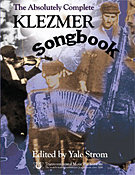
The Absolutely Complete Klezmer Songbook

If anyone can be called an expert on Klezmer, it’s Yale Strom. With ten books, ten CD’s, six documentary films, two plays, a symphony, and twenty five research expeditions in central and Eastern Europe to his credit, Yale has clearly dedicated a large part of his life to the study and revival of klezmer in all its forms.
This book opens with a detailed history of klezmer from its earliest roots in the time of the Temple of Jerusalem, through the tortuous history of the Jews in medieval Europe, where not least among the problems musicians faced was the disapproval of their own rabbis. Weddings have always been the central focus of klezmer, and Yale documents the gradually changing role of the musician; “over time the profession of the lets (an all purpose entertainer) evolved into those of the marshalik (master of ceremonies), and the batkhn, the wedding bard. These names were sometimes used interchangeably…it appears that these various occupations gradually melded into that of the klezmer, a term popular from the 18thC through today.” The role of violinist as band leader and emotional focus of the music is examined; “The klezmer violinist was an extension of the khasn’s voice”, and “the klezmer’s ability to imitate the crying, ululating, moaning and laughing cantorial techniques he had heard since he was an infant were shaped into specific klezmer ornamentation”
Five dreydlekh or core techniques are described, as well as the four chief modes on which klezmer melodies are constructed. The claim that this is the “absolutely complete” klezmer songbook may be an exaggeration, but with 313 numbers who’s to complain? Henry Sapoznik’s The Compleat Klezmer had just 33. The tunes are grouped by type; Processionals, Bulgars, Freylekhs, Horas, Skotshnes, Shers, Nigunim and so on, and they range from tunes known universally in the Jewish world, to rare treasures that he has unearthed on his travels. Thirty six of the tunes are recorded on an accompanying CD and, unusually for a “book cd”, these are quality recordings with Yale’s violin accompanied by his band Hot Pstromi; the tunes are beautifully arranged and played, making this a proper listening cd in its own right. A second CD, “Absolutely Klezmer Volume 2” is available separately, with a further 17 tunes from the book, this time with longer arrangements and some extended improvisation.
This book is a gem, and with people like Yale Strom behind it, the Klezmer revival is in safe hands.
Henry Sapoznik had a key role in the late 20thC revival of klezmer in the United States, and this book was one of the major sources of dissemination of the almost-lost repertoire. The 33 tunes are written clearly and simply, the keys (often D minor or D major) easily accessible on the fiddle. Divided into Horas, Terkishes, Khosidls, Khupes and Doinas, many of these numbers are at the core of the klezmer repertoire. Among the best known are Tanz, Tanz Yidelekh, Ot Azoi, Der Shtiler Bulgar, Odessa Bulgar, and Kandel's Hora.
Sapoznik's intoduction gives a deep insight into the circumstances surrounding the revival, and the notes by Pete Sokolow give an invaluable summary of the dance forms, scales, rhythms and instrumentation of klezmer. The discography is revealing; writing in 1987 he could list less than a dozen contemporary klezmer bands with recordings. Today the list would be in the hundreds; and there would be few of those musicians who would not admit to owning a well-thumbed copy of The Compleat Klezmer.
Cravitz, Ilana - Klezmer Fiddle: a How-To Guide - Book and CD for Violin - Oxford University Press
Playing klezmer fiddle is as much about the sound as the tunes. To bring them to life you need to understand many aspects of bowing, articulation, phrasing and ornamentation which are not obvious from the melodies. Ilana Cravitz's book provides the detailed analysis of performance which will give you the authenticity of sound which will make you a real klezmer player.Trills, slides, the krekhts ( a sort of fingered sob), finger positions and vibrato are all demonstrated with reference to 16 tunes. The playing on the accompanying cd is clear and authoritative, and also included are separate parts for sekund (rhythm fiddle) and bass, making this a valuable resource for anyone starting up a klezmer band from scratch.
The Jewish Fake Book (Fake Books)

Despite the success of the Klezmer rivival, the material that remains most popular at most Jewish weddings and bar mitzvahs is this "Simcha music"; mostly relatively modern modern compositions, usually vocal, in Hebrew, and usually recorded with "pop" backing. It's not my cup of tea, but nevertheless these tunes are essential, and until I got hold of this book, my only way of accessing them was by copying them from other musicians' pads. The Jewish Fake Book has 180 tunes, subdivided into "Klezmer and Wedding", "Israeli Dance", "Songs of Israel", "Yiddish", "Somgs in English", "Sephardic and Oriental", "Sabbath and Holidays", and Hassidic and Liturgical". They all come with words and chords as well as top line. Learn these tunes and you'll never be out of work. At least, never on a Sunday!
Klezmer! Jewish Music From Old World To Our World (Omnibus Press)

This is a fascinating, detailed and comprehensive history of klezmer from its roots in eastern and central Europe, the establishement of musical guilds and klezmer dynasties, the 19th C exodus to America, the twists and turns of Yiddish popular music in the New World, to the decline and eventual late 20thC revival. As a key figure in this revival, Sapoznik is able to give an engaging and very personal view of this revival, and he has added many wonderful and colorful details to our knowledge of klezmer. Of most interest to me was the section on Yiddish Melodies in Swing; the 1930's and 40's fusion which gave us such songs as And the Angels Sing, and Bei mir Bist du Shon.
There may be a great deal of scholarly research in here, but writing is informal and accessible, and this is a book of interest to musicians and non musicians alike. It comes with a 22 track cd including many rare and historic recordings, including the legendary Belf Romanian Orchestra, Abe schwartz's orchestra , and the great clarinetists Harry Kandel and Naftule Brandwein.
Dave Tarras - The King of Klezmer

by Yale Strom
Dave Tarras, the King of Klezmer, was not only arguably the greatest klezmer clarinettist of his generation, but the longevity of his life and career made him a unique figure in klezmer history. It was a career that spanned the Old World of Tzarist Russia, the pogroms, emigration to the USA, the golden age of klezmer and Yiddish theatre in New York, the postwar decline and eventual 1970’s revival. He was part of all this: “Tarras represented that last link to the klezmer world of the late 19thC and turn-of-the-century era”; and Yale Strom’s biography gives us an intimate and detailed insight into that career, based on deep research and many personal interviews.
Tarras’s talent shone from the earliest age, whether it was in his family kapelye in Ternovka, Russia, in the Tzarist army ("at night while he entertained the officers, the rest of his bretheren were on the front fighting the Germans. For a while, music shielded Tarras from the horrors of war”, or in the dance halls of New York; “there is nothing he did that was not immediately taken up by other clarinettists” Strom leads us on a fascinating story right through to Tarras’s death in 1989, at the age of 92. By this time the new generation of klezmer musicians, fellow clarinettist Andy Statman in particular, were fully aware of the importance of his legacy.
This book, rounded off with a collection of 28 Tarras compositions (presented in both C and Bb), is a resource which any klezmer player, whether a clarinettist or not, should treasure.
